Volleyball drills for technique defense / passing / digging / diving / reception
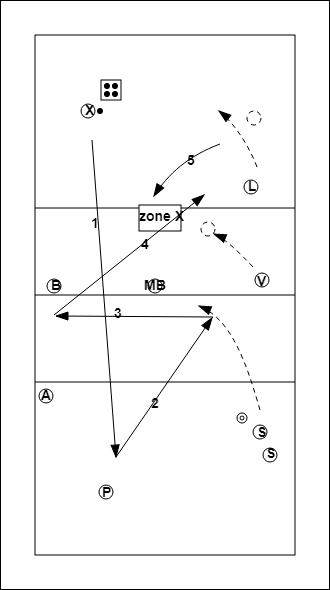
- Objective :
- defense zone 4-5 according to defense system :
- block open-toe
- Execution :
- A = attacker |
- S = setter |
- P = passer |
- B = blocker |
- MB = middle block |
- V = defender |
- X = player
- X serve --> A/P --> pass --> S ( penetration pos 1)- S set-up
--> A pos 4- A -->
attack zone 4-5- V/L -->
defense in zone X
- extension :
- MB at post
- after defense it gives the set-up for pipe --> by X
- 4 gives setup on 1 and 1 attacks on 2.
- 2 defends to 3,
- 3 gives setup on 2 and 2 attacks on 1,
- 1 defends on 4 and it starts all over again.
- After 3 and 4 have given 5 setups they switch,
- the challenge is to do this while keeping the ball in play.
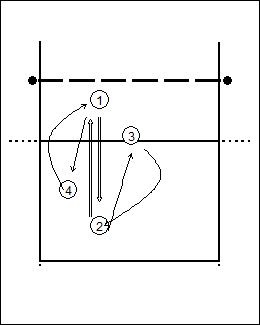
- Three defenders in the field
- One person who catches
- Rest: serve
- Strikes follow each other quickly
- Each person in the field must make 5 perfect receptions to the receiver.
- Catcher determines if the reception is good
- When a defender has made 5 perfect receptions, he becomes a catcher and the catcher starts to serve
- Hang up the net at about 1,50 m.
- Work with 4 players, 2 on each side of the net.
- Player smashes the ball down, pass to player at the net
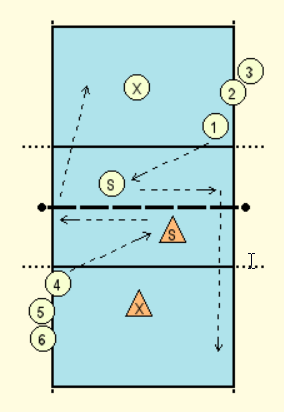
The purpose of the exercise is twofold: the defender must learn to 'read' where the attacker is going to hit and the attacker must look where the defence is before hitting.
We work with two regular playmakers, on both sides of the field a row of attackers on the left-for position. And two defenders, who may choose where they position themselves on the field. A defender has to defend the attack 10 times, preferably a nice pass, but touching is enough. If the attacker hits the net or leaves the field, that also counts. And the attackers may only smash, no prick balls! After the attack, the attacker retrieves the ball and joins the other row. The attacker who defends the ball at the 10th time takes the place of the defender. The defender will then of course attack.
Necessary:
- 8 - 10 players
- enough balls
If there are less players, the exercise can also be done, but then on one side. The attacker retrieves the ball and joins the same line.
The blocker joins in, indicates where he is going to block and the mid-back goes to his place.
Besides technique, communication is very important in volleyball. And both aspects apply to this exercise. And respond adequately to situations which are different than normal. In such an exercise you see very well how different players are.
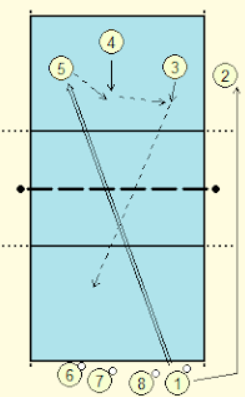
3 players position for passing (numbers 3, 4 and 5). Player 2 is ready on the side of the same side. The other players are ready with the ball to serve on the other side.
- Player 1 serves the ball (and immediately walks back to where player 2 is standing).
- A player passes the ball. Another player sets up. And a third player plays the ball over the net. All three players have to play the ball, or pass, or set up, or attack
- When the ball is over the net, the players rotate: 2 enters the field (where 3 was standing) 3 goes to centre back, 4 goes to where 5 was standing, and 5 goes to the serving spot on the other side.
- Then the next player can serve, player 8 on the drawing etc.
Necessary:
- 4 balls
- 7-8 players
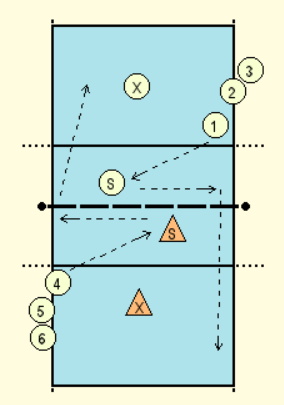
- The goal of the exercise is twofold: the defender must learn to 'read' where the attacker is going to hit and the attacker must look where the defence is before hitting.
- We work with two regular playmakers, on both sides of the field a row of attackers on the left-for position.
- And two defenders, who may choose where they position themselves on the field.
- A defender has to defend the attack 10 times, preferably a nice pass, but touching is enough.
- If the attacker hits the net or leaves the field, that also counts.
- And the attackers may only smash, no prick balls!
- After the attack, the attacker retrieves the ball and joins the other row.
- The attacker who defends the ball at the 10th time takes the place of the defender.
- The defender will then of course attack.
Necessary:
- 8 - 10 players
- enough balls
If there are less players, the exercise can also be done, but then on one side. The attacker retrieves the ball and joins the same line.
The blocker joins in, indicates where he is going to block and the mid-back goes to his place.
- Passing over the net oh/bh.
- Walk under the net around the pawns.
- Perform defensive actions while walking.
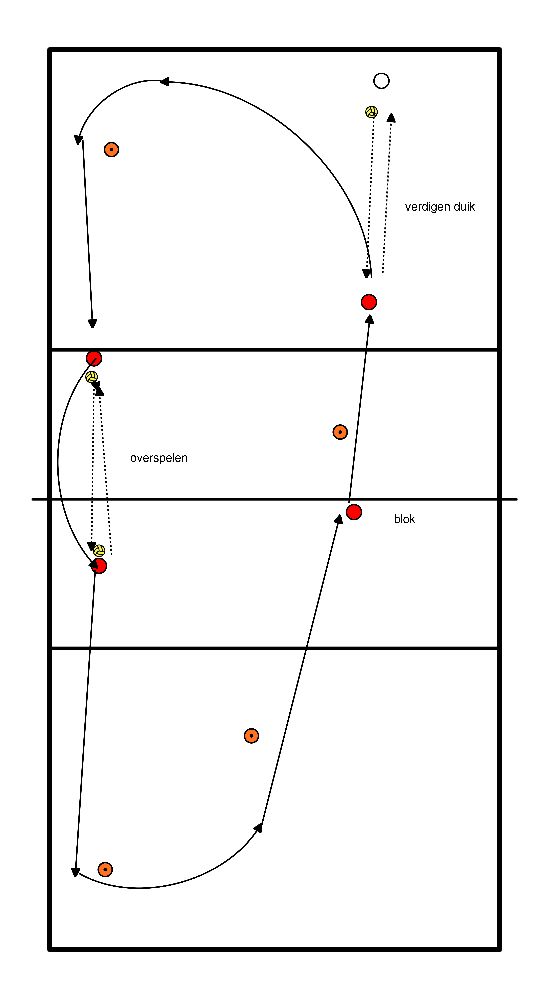
- there is an arrangement of 6 in the field
- the others stand on the other side
- Player 1 serves and the rally is played out. After the service player 2 throws a rally ball into the game.
- after every service + rally ball (2 balls in total) a spot is rotated. when we are round we change players.
- 4 cones in the corners, 1 central base to which the player always returns.
- The player moves to one of the cones and plays the ball back OH, the intention is to recover the ball well.
- Short and quick ball changes.
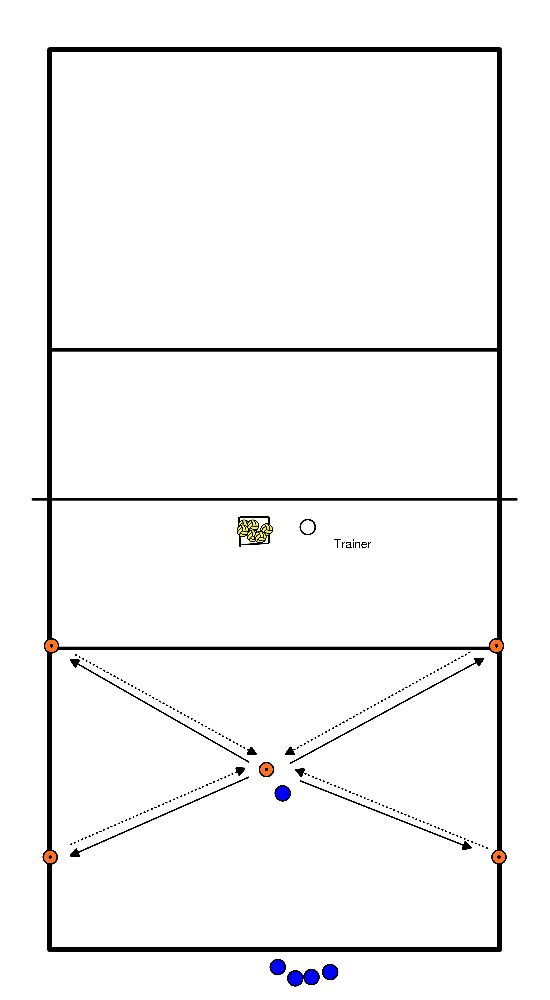
- With ball in the corner on position 1 and 5
- Key to center
- Key from center to position 4 and position 2
- Catch for bots
- Player 1 at position 4 a.h. net & Player 2 at position 2 a.h. net - with ball in the corner at position 1 and 5
- Pass to the centre
- Pass from centre to position 4 and position 2
- Catch
- Player 1 at position 4 a.h. net & Player 2 at position 2 a.h. net - with ball in the corner at position 1 and 5
- Position 4 and 2 play short type ball
- Player 1 at position 4 a.h. net & Player 2 at position 2 a.h. net - with ball in the corner at position 1 and 5
- Position 4 and 2 play attack 2x
- line up one side of the net on the other side players with ball to attack,
- I pass, the other players react and
- the passer catches the ball and runs on.
- The attacker becomes a reserve,
- reserve becomes defender,
- defender becomes passer,
- passer runs up the ladder and becomes attacker.







